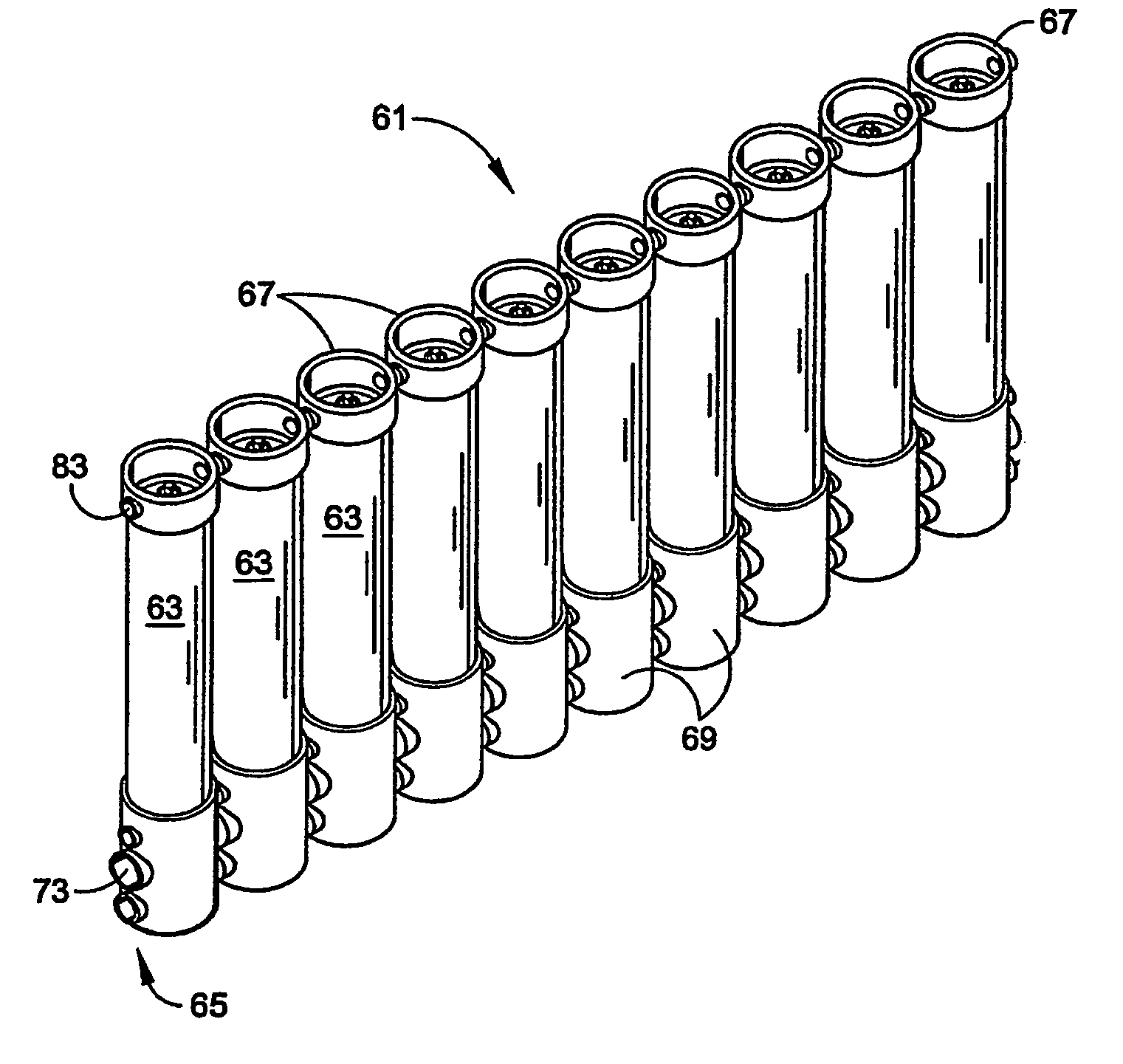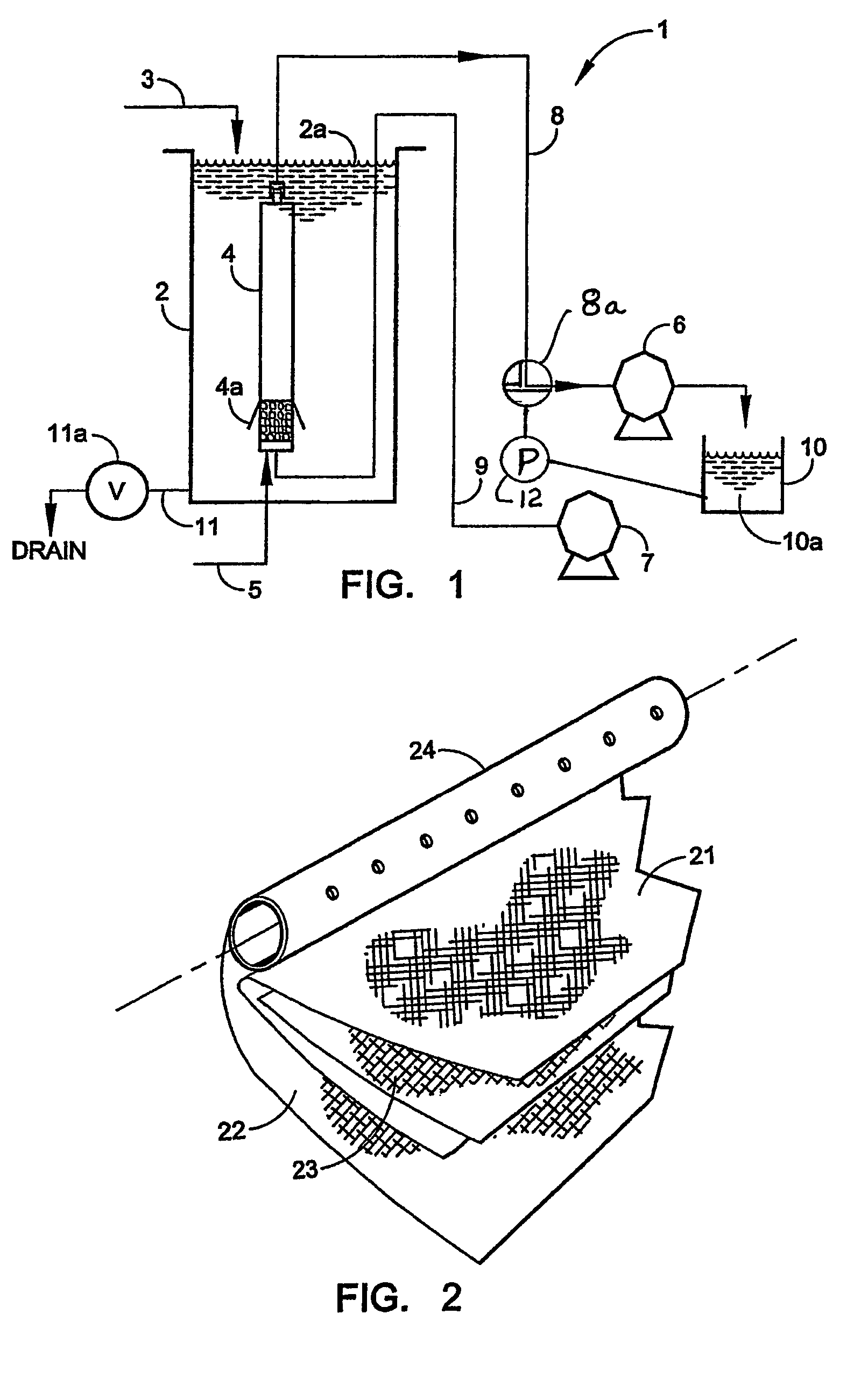Low pressure filtration
a technology of low pressure and filtration, applied in the direction of filtration separation, membranes, separation processes, etc., can solve the problems of increasing system downtime, reducing the overall system efficiency, and impractical draining a large process tank used for existing submerged membrane systems
- Summary
- Abstract
- Description
- Claims
- Application Information
AI Technical Summary
Benefits of technology
Problems solved by technology
Method used
Image
Examples
example 1
[0065]A polyethersulfone ultrafiltration membrane cartridge, which is sold under the trademark SpiraSep 900 by TriSep Corporation of Goleta, Calif., having a clean water flux rate of about 30 gallons per square foot per day per psi (gfd / psi), having a diamond shaped feed spacer thickness of about 115 mil (3 mm) and a total active membrane surface area of 178 ft2 is employed as the cartridge depicted in FIGS. 5 and 12. It is operated on a wastewater feedstock from a municipal wastewater plant wherein the feedstock carries 100 ppm of suspended solids. The membrane cartridge 63 is attached to a base and has an upper cap 67 to collect overflow during backwashing. The membrane cartridge is operated in a dead-end mode during the filtration cycle, so that no feedstock is overflowing during the filtration cycle; thus, during the filtration cycle, the feedstock feed rate is equal to the permeate flow rate. The membrane cartridge 63 is initially operated at a TMP of about 2.0 psi supplied by ...
example 2
[0067]Another spirally wound membrane cartridge is constructed having with the same physical description given in Example 1, except a corrugated spacer with a thickness of about 80 mil (2 mm) and peak to peak distance of about 4.3 mm is used; the resulting active membrane surface area is about 220 ft2. The membrane cartridge is installed and operated on wastewater from a cheese plant with feed characteristics of about 1,000 ppm total suspended solids (TSS).
[0068]A vacuum is generated, by means of a centrifugal pump, to maintain a TMP of about 2 psi, and air is continuously delivered to a gaseous diffuser below the open bottom end of the cartridge at a rate of 6.2 scfm. The membrane cartridge is operated in a dead-end mode during the filtration cycle so that only air flows out the cap, except during backwashing. Backwashing using permeate at a pressure of about 4.0 psi is repeated every 5 minutes for a period of 30 seconds. After every backwash, a drain valve is opened, and the feeds...
example 3
[0070]Two spirally wound membrane cartridges are configured with the same physical construction described in Example 1 but with a PVDF membrane chemistry, and they are operated on effluent from a municipal wastewater activated sludge process. They are connected in series flow in a vertical orientation to create a pair of stacked cartridges where the feedstock being supplied flows upward through the feed spacers in the lower cartridge and then through those in the upper one. They are operated in dead-end mode. This stacked configuration reduces overall footprint by 50%.
[0071]Effluent from the activated sludge process typically has a turbidity about 80-100 NTU. The stacked arrangement is operated at a permeate flux rate of about 30 gfd, and air is periodically bubbled into the feedstock in the base at a rate of 3.1 scfm for a total of only 3 minutes out of every 10 minutes. The system is backwashed every 20 minutes for 40 seconds, and after every backwash, the liquid feedstock is drai...
PUM
| Property | Measurement | Unit |
|---|---|---|
| thickness | aaaaa | aaaaa |
| thickness | aaaaa | aaaaa |
| thickness | aaaaa | aaaaa |
Abstract
Description
Claims
Application Information
 Login to View More
Login to View More - R&D
- Intellectual Property
- Life Sciences
- Materials
- Tech Scout
- Unparalleled Data Quality
- Higher Quality Content
- 60% Fewer Hallucinations
Browse by: Latest US Patents, China's latest patents, Technical Efficacy Thesaurus, Application Domain, Technology Topic, Popular Technical Reports.
© 2025 PatSnap. All rights reserved.Legal|Privacy policy|Modern Slavery Act Transparency Statement|Sitemap|About US| Contact US: help@patsnap.com



